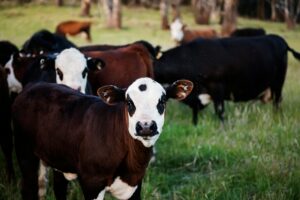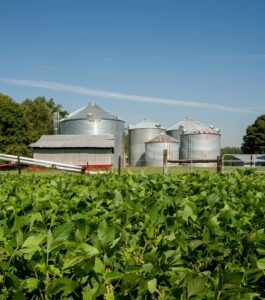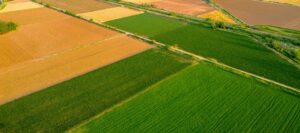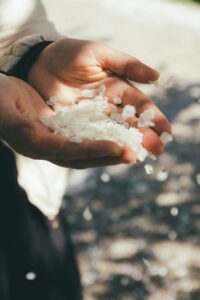Introduction
Fertilisation is a method of improving the nutritional status of the soils, and can be tailored to provide the correct nutritional requirements at the most appropriate time.
Fertilisers are food for plants; they contain plant nutrients (nourishing substances), which all plants need to grow and stay healthy.
Plants take carbon (C) from the air and 12 elements from the soil: Nitrogen (N), phosphorus (P), and potassium (K) are used in relatively large amounts. Sulphur (S), calcium (Ca), and magnesium (Mg) are also often required. Zinc (Zn), iron (Fe), manganese (Mn), Boron (B), copper (Cu) and molybdenum (Mo) are other elements.
The soil provides most of the nutrients needed, and shortages can be overcome by using carefully chosen fertilisers. It would be wasteful to apply a nutrient if your soil already has sufficient.
In general, macro elements such as nitrogen (N), phosphate (P) and potassium (K) are the nutrients most likely added to the soil.
| Applying nitrogen (N) improves overall crop quality. It helps plants develop the green colour they need to take food from the sun, and to take the necessary food from the soil. N increases the number of branches, leaves, seeds and fruits, and accelerates the number of plant cells in the plant. A shortage of nitrogen will result in yellow leaves and poor plant growth. | |
| Phosphorous (P) | Adding phosphorous (P) to the soil leads to better root development, helps with grain and seed development. Plants are assisted to ripen early and mature quickly. |
| Potassium (K) | The addition of potassium (K) to the soil improves crop yields and quality, strengthens plants and helps them resist drought and disease. It helps the plant to breathe and plays a major role in the plant’s use of water (stomata) and its build up of starches, sugars, fats and protein. |
Although NPK volumes are the highest, it is of utmost importance to emphasise the necessity of all other elements too.
| Magnesium (Mg) | Magnesium (Mg) helps plants to breathe and phosphorous to get into the plant. Mg is a vital element in photosynthesis. Too much will slow down the plant’s ability to absorb potassium. |
| Calcium (Ca) | Calcium (Ca) forms the ‘building blocks’ in plant cells which ensure firmness, shelf life and quality produce. Calcium (Ca) strengthens plants and reduces/neutralises toxicity in the soil. |
| Sulphur (S) | Sulphur (S) is essential for uptake of Nitrogen (N). S helps in leaf development and increases the quality of grain and fruit. It is responsible for flavour attributes in crops such as onions and garlic. |
| Zinc (Zn) | A key constituent of many enzymes and proteins |
“Straight” and “multi-nutrient” fertilisers
Fertilisers are either “straight” or “multi-nutrient”. Straight fertilisers are products containing one of the main plant nutrients. Some examples are given below:
| Plant nutrient | Fertiliser |
| Nitrogen (N) | Urea Calcium ammonium nitrate (CAN) Limestone ammonium nitrate (LAN ) Ammoniumsulphate (AS21) |
| Phosphate (P) | Single superphosphate (SSP) Triple superphosphate (TSP) Monoammoniumphosphate (MAP) |
| Potassium (K) | Muriate of potash (MOP) Potassium-nitrate (KNO3) and potassium-sulphate (SOP) |
P and K are shortened forms: P = P2O5 x 0.44 and K = K2O x 0.83
Multi-nutrient fertilisers contain more than one of the main plant nutrients. There are figures (numbers) printed on a fertiliser bag which will give you the ratios of plant nutrients of that fertiliser. They always follow the same sequence. The first number is the ratio of N, the second is the ratio of P, and the third refers to the ratio of K. Divide the figure given in the ration by 9, and then multiply it by 30. So 3.2.4. (30), for example, means that the fertiliser contains 10% of N, 6.6% of P and 13% of K.
(The above information is taken from the Fertiliser Retailing Guide, put out by the Food and Agriculture Organisation of the United Nations, the Fertiliser Industry Advisory Committee; and Omnia, Yara and Kynoch).
The ‘Law of the minimum’ illustrated by barrel staves of varying lengths represent growth-controlling factors. This is also known as Liebig’s law. The barrel story illustrates that success will be limited / handicapped by that element which is deficient. If only one element lacks in availability or is inadequate in supply one will not achieve optimum results. This is why a comprehensive nutrient programme or “balanced diet” is important.
***
What is the effect of water on fertiliser in the soil?
Water dissolves the fertiliser. The nutrients are carried by the soil water to the roots of the plant. If there is not enough water in the soil, the nutrients cannot reach the roots of the plant, nor can they be absorbed by the plant.
Can a farmer apply too much fertiliser?
Excessive fertiliser use can damage crops and reduce yields. It contributes to pollution of soil and ground water. Apart from also being a waste of money, it damages the overall image of agriculture when it comes to looking after the environment.
How do I know how much fertiliser to apply?
This depends on soil and crop. Clay soil, for example, requires a totally different application to sandy soil. If you want to know what fertiliser you need and how much to apply to your soil, take a soil sample from your land or a leaf sample from one of your crop plants and have it tested at an agricultural laboratory or a place where soil can be analysed to show which nutrients are lacking. These places can give a fertiliser recommendation. This money will be well spent because it can save you thousands later.
When is the time to apply fertiliser?
If fertiliser is applied at the wrong time, the yields will be lower and the farmer will make less money. The “basal” dressing should generally be applied at planting, and the “top” dressing should usually be completed before the plant flowers.
Best Fertiliser Practice
Fertiliser need
Over fertilising or under fertilising will affect your profit – too much will increase your costs and be bad for the environment; not putting enough fertiliser on will decrease the yield and thus your income. Two factors will assist you:
- A soil analysis is crucial. Take a soil sample, representative of the field (don’t just take the sample from one place). The interpretation of the analysis must be soil and crop specific. It is recommended that you ask a specialist for help.
- Determine the target yield.
Liming
Liming must by no means be neglected. Too much acid in the soil:
- decreases the availability of phosphorus
- inhibits the efficient uptake and use of both water and fertiliser
- renders applied herbicides insufficient
- suppresses the effectivity of micro-organisms in the soil
- mean heavy metals such as Aluminium (AI), toxic to the plant, become present
Under highly acidic conditions it can, from an economic point of view, even be more beneficial to lime instead of increasing the fertiliser application rate.
Biological life
The biological life in the soil was neglected in the past. The value of micro-organisms in soil mustn’t be underestimated (and organic matter is food for micro-organisms). The positive influence of a well balanced, healthy micro-organism population on the availability of plant nutrients has been well proven. Experts are available to advise farmers accordingly.
Do not neglect the biological life in the soil. A healthy micro-organism population make more plant nutrients available – a great benefit. Experts are available to advise you.
Product choice
Compare the pros and cons of the different products. More concentrated products can reduce costs (there is less to transport), but in general do not contain the same amount of secondary elements.
Application
Although band placement of fertiliser is generally the most effective, there is a place and time for broadcast application and foliar sprays. The method of fertiliser application has a definite effect on fertiliser efficiency.
Precision farming
This ensures that the whole field is fertilised according to the soil analysis, remote sensing etc. (see “Digital agriculture” page), and expected yield. Money is saved, yields are increased and risk is reduced.
Water use
Determine the water content of every field. If there is not enough, then plant less or don’t plant at all. Effective weed control is important since water and plant nutrients are consumed by weeds.
Plant sap analysis/plant tissue analysis
Taking regular plant sap samples/plant tissue analysis will help you to address nutrient deficiencies in time. They will also prevent unnecessary fertiliser being applied.
Source: adapted from the article “Best Fertilizer Practices” which appeared in Volume 14 of The FarmAfrica, with additional comments from Yara.
International business environment
The South African industry’s margins are determined largely by world market prices of major raw materials, while domestic prices are primarily driven by import parity cost of commonly traded fertiliser commodities.
The main fertiliser consumers in Africa include Egypt, South Africa and Morocco. Total fertiliser consumption in sub-Saharan countries is approximately 1% of the world fertiliser consumption.
Russia and China are the largest exporters of fertilisers (Opperman et al., 2025). Brazil, India and the US are the largest importers of fertilisers (Opperman et al., 2025).
Further reference:
- The International Fertilizer Association (IFA)’s Market Intelligence Service provides updated reports and statistics at www.IFASTAT.org.
- www.fertasastats.co.za provides trade statistics.
- The various presentations under “Events” at www.fertasa.co.za are also a source of useful information.
- Find the discussion of the global fertiliser market in the BFAP Agricultural Outlooks. See www.bfap.co.za.
- The Africa Fertilizer Financing Mechanism is a special fund housed at the African Development Bank. See www.afdb.org/en/affm.
- Read about the African Fertilizer and Agribusiness Partnership (AFAP) at www.afap-partnership.org. Its East and Southern Africa Fertilizer Trade Platform (ESAF) is designed “to facilitate and co-ordinate enhanced private sector investment and participation in the procurement and distribution of fertilizer in the region”.
- The latest Africa Agriculture Status Report includes an overview of the continent’s fertiliser sector. Find it at https://agra.org/publications/africa-agriculture-status-report-aasr/.
View the following websites:
- African Green Revolution Forum (AGRF) – https://agrf.org
- www.agindustries.org.uk – Agricultural Industries Confederation (UK)
- https://fertilizerseurope.com – Fertilizers Europe
- www.ifdc.org – International Fertiliser Development Centre
- www.fertilizer.org – International Fertilizer Association
- www.ipipotash.org – International Potash Institute
- www.ipni.net – International Plant Nutrition Institute
- www.fertiliser-society.org – The International Fertiliser Society
- www.sulphurinstitute.org – The Sulphur Institute
South Africa: imports and exports
- South Africa mainly imports fertiliser from Saudi Arabia, Russia, Qatar, China, Germany and Oman. The value of South African imports in 2023 was USD 824 million (Opperman et al. 2025).
- South Africa exports fertiliser to Zambia, Zimbabwe, Namibia, Botswana and Eswatini (Opperman et al., 2025).
- Fertasa does an analysis of import and export data, available to members. See www.fertasastats.co.za.
Local business environment
As a net importer of fertiliser, the country is vulnerable to events in the international community which cause price volatility and supply chain disruptions.
In South Africa the maize industry consumes between 40% and 50% of all fertilisers and the market, therefore, is much influenced by what happens to this industry. Fertiliser, for these farmers, can account for 35% of total input costs (Sihlobo, 2025).
Negatives for the fertiliser industry include a land reform policy where it takes some time for new farmers to be fully established as commercial farmers, and if farmers were discouraged from planting maize and went instead for crops which use less fertiliser than maize. The emergence of a biofuel industry would be a positive for the industry as the crop demand would impact favourably on the need for fertiliser.
Further reference:
- www.fertasastats.co.za provides trade statistics.
- The various presentations under “Events” at www.fertasa.co.za are also a source of useful information.
- Find the monthly Chemical and fertilizer report on the Grain SA website, www.grainsa.co.za.
- The BFAP Agricultural Outlooks look at the effect of steep input costs on farmer profitability. Find the document at www.bfap.co.za.
National strategy and government contact
The “Legislation & regulations” option at www.fertasa.co.za is of great help here. It sets out the fertiliser regulations, registration documentation and contacts at the Department of Agriculture. The reader can also find information by looking for the “Agriculture Inputs Control” option at www.nda.gov.za.
The Fertilisers, Farm Feeds, Agricultural Remedies And Stock Remedies Act, 1947 (Act No. 36 of 1947) provides for:
- the appointment of a Registrar of Fertilisers, Farm Feeds, Agricultural Remedies and Stock Remedies;
- the registration of fertilisers, farm feeds, agricultural remedies, stock remedies, sterilising plants and pest control operators;
- to regulate or prohibit the importation, sale, acquisition, disposal or use of fertilisers, farm feeds, agricultural remedies and stock remedies;
- the designation of technical advisers and analysts.
The main provisions of Act No 36 of 1947 are: control over the registration of fertilisers, farm feeds, agricultural remedies, stock remedies, sterilising plants and pest control operators; to regulate or prohibit the importation, sale, acquisition or disposal of these inputs. This Act applies where a person imports, sells, acquires or disposes the mentioned articles. It is therefore advisable to be aware of these requirements. The Act is currently being revised and a Fertiliser Bill is out. Keep your eyes on the “Legislation & Regulations” option at www.fertasa.co.za.
Understanding and anticipating global trends, strengthening ties with reliable suppliers and diversifying import sources are critical to this country’s agriculture (Opperman et al., 2025).
Role players
View the Premium Listings below (scroll down or click on “Premium Listings” on the Table of Contents to the right).
Further reference:
Training and research
- The Agricultural Research Council campuses periodically do fertiliser-related research.
- Fertiliser Advisors, Certification and Training Scheme (FACTS), a fertiliser advisors’ training course, administered by the Fertasa, is aimed at improving the skills of fertiliser advisors. Candidates are drawn from private sector, government, agri-business and co-operatives, as well as neighbouring countries. The course is open to all interested persons. A Product Registration Application System (PRAS) short course is also run. Find details of all training at www.fertasa.co.za.
- Fertiliser companies conduct in-house training and research within their own Research and Development departments.
- Find universities, agricultural colleges and other role player details on the “Agricultural education and training” page.
Companies
- Find details of all Fertasa members at www.fertasa.co.za.
- Details of further laboratories appear on the “Laboratories and agriculture” page.
Biofertilisers
- See the “Speciality fertilisers” page for a full list of role players.
Organic fertiliser producers
- See also the “Compost & organic fertiliser” page.
Websites and publications
Visit the websites listed earlier on this page.
The following publications are available from Fertasa:
- Fertilizer Handbook (also available in Afrikaans). This is a hard cover handbook that has primarily been written for the use of persons who are involved in some way or another in a fertiliser advisory capacity. It is not intended to be a complete technical handbook, but rather a concise presentation covering a wide range of topics. For this reason, interested farmers and students will also find it to be a useful guide. It is prescribed as part of the agricultural curriculum at some universities and universities of technology in South Africa.
- Deficiency Symptoms in Maize. A4-size colour pamphlet depicting the deficiency symptoms in maize.
- Plantfood & Fertilizers. Illustrated publications for the emerging farmer. A4-size, in ring-binder format.
- Soil Acidity and Agricultural Lime (also available in Afrikaans as Grondsuurheid & Landboukalk). This brochure contains the two chapter “Soil acidity” and “Agricultural lime” which appear in the Fertilizer Handbook. This brochure is intended as a general guide for agronomists and farmers alike who have a common purpose in sound liming.
- Soil Fertility. Illustrated publications for the emerging farmer. A4-size, in ring-binder format.
- Fertasa Journal – a publication containing the proceedings of the Fertasa annual congress
- The Proceedings of previous Symposiums
Visit www.kejafa.com for the following publications from Kejafa:
- Bemesting Fertilizer
- Sea Energy Agriculture
- Fertility from the ocean deep
- Fertilizer Handbook
The ARC‘s excellent Maize Information Guide (MIG) includes notes on fertilisation. Download it from www.arc.agric.za.
Ottermann HT, Truter KJ, Haarhoff SJ, van der Westhuizen D, Meyer F & Swanepoel PA. 2025. Trends and drivers of fertiliser consumption in the South African agricultural industry. Agrekon 64(2). Available at www.tandfonline.com/doi/full/10.1080/03031853.2025.2515868
Take a look at the annual South African fertiliser market analysis report on the Department of Agriculture website, www.nda.gov.za. On the same website, find the Info Paks that deal with soil. These include “Soil: acid soil and lime” and “Soil: application of lime”.
Neil Miles, renowned soil scientist, runs the Agrispex Soil Productivity Expertise website, https://agrispex.co.za. Find the many articles to do with soil and fertilisers here.
Read the AgriSETA Assessment Guide Primary Agriculture “Soil fertility and plant nutrition”.
Some articles:
- Reporter. 2025, December 12. “South Africa expands lime production in Limpopo.” Fresh Plaza. Available at www.freshplaza.com/africa/article/9794021/south-africa-expands-lime-production-in-limpopo/
- Baffes J & Temaj K. 2025, December 04. “Fertilizer prices soften but remain constrained by trade policies.” World Bank Blogs. Available at https://blogs.worldbank.org/en/opendata/fertilizer-markets-soften-but-remain-constrained-by-trade-polici
- Reporter. 2025, November 25. “Department finalises over 6 000 fertiliser and farm feed applications.” SA News. Available at www.sanews.gov.za/south-africa/department-finalises-over-6-000-fertiliser-and-farm-feed-applications
- Ottermann H, Truter K, Haarhoff S, van der Westhuizen D, Meyer F & Swanepoel P. 2025, September 2. “FERTILISER INDUSTRY IN SA: This is what it looks like.” SA Graan/Grain. Available at https://sagrainmag.co.za/2025/09/02/fertiliser-industry-in-sa-this-is-what-it-looks-like
- Ottermann H, Truter K, Haarhoff S, van der Westhuizen D, Meyer F & Swanepoel P. 2025. “Global fertiliser trends: Implications for South Africa’s oilseeds industry.” Oilseeds Focus. Available at www.bfap.co.za/wp-content/uploads/2025/09/Global-fertiliser-trends_Sept_2025.pdf
- Staff Reporter. 2025, July 16. “Fertilizer prices may be slightly higher when the 2025-26 production season starts in South Africa.” Agricultural Economics Today. Available at https://wandilesihlobo.com/2025/07/16/fertilizer-prices-may-be-slightly-higher-when-the-2025-26-production-season-starts-in-south-africa/
- Baffes J & Tema K. 2025, July 09. “Fertilizer prices gain momentum amid strong demand and geopolitical tensions.” Data Blog. Available at https://blogs.worldbank.org/en/opendata/fertilizer-prices-gain-momentum-amid-strong-demand-and-geopoliti
- Ehlers L. 2025, June 2. “There is no blanket solution in NUE.” Agribook. Available at www.agribook.co.za/there-is-no-blanket-solution-in-nue/
- Antip M. 2024, November. “Fertilizer market developments”. Food Outlook. Available at www.agbiz.co.za/document/open/fertilizer-market-developments-893h
- Reporter. 2024, November 25. “Promoting food security, building a sustainable business”. SouthAfrican Business. Available at www.southafricanbusiness.co.za/11/2024/resources/agriculture-forestry-fishing/promoting-food-security-building-a-sustainable-business
- Nkunjana T. 2024, September 19. “Global fertiliser prices ease, but challenges persist for farmers”. Food for Mzansi. Available at www.foodformzansi.co.za/global-fertiliser-prices-ease-but-challenges-persist-for-farmers
- Smith A & Ramachandran V. 2024, May 1. “The West Needs to Come to Grips with African Fertilizer Needs”. Center for Global Development. Available at www.cgdev.org/blog/west-needs-come-grips-african-fertilizer-needs






